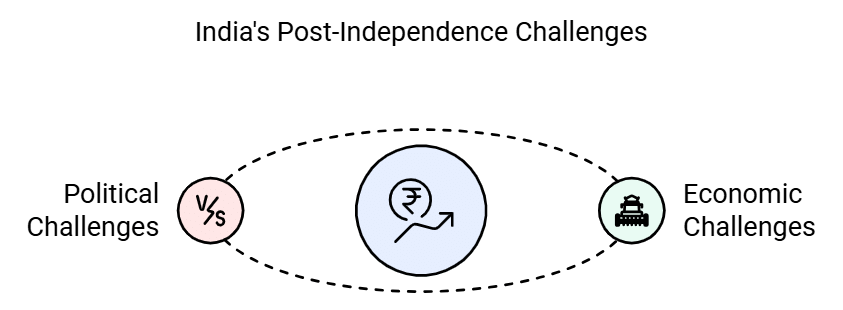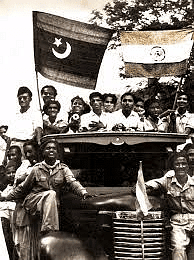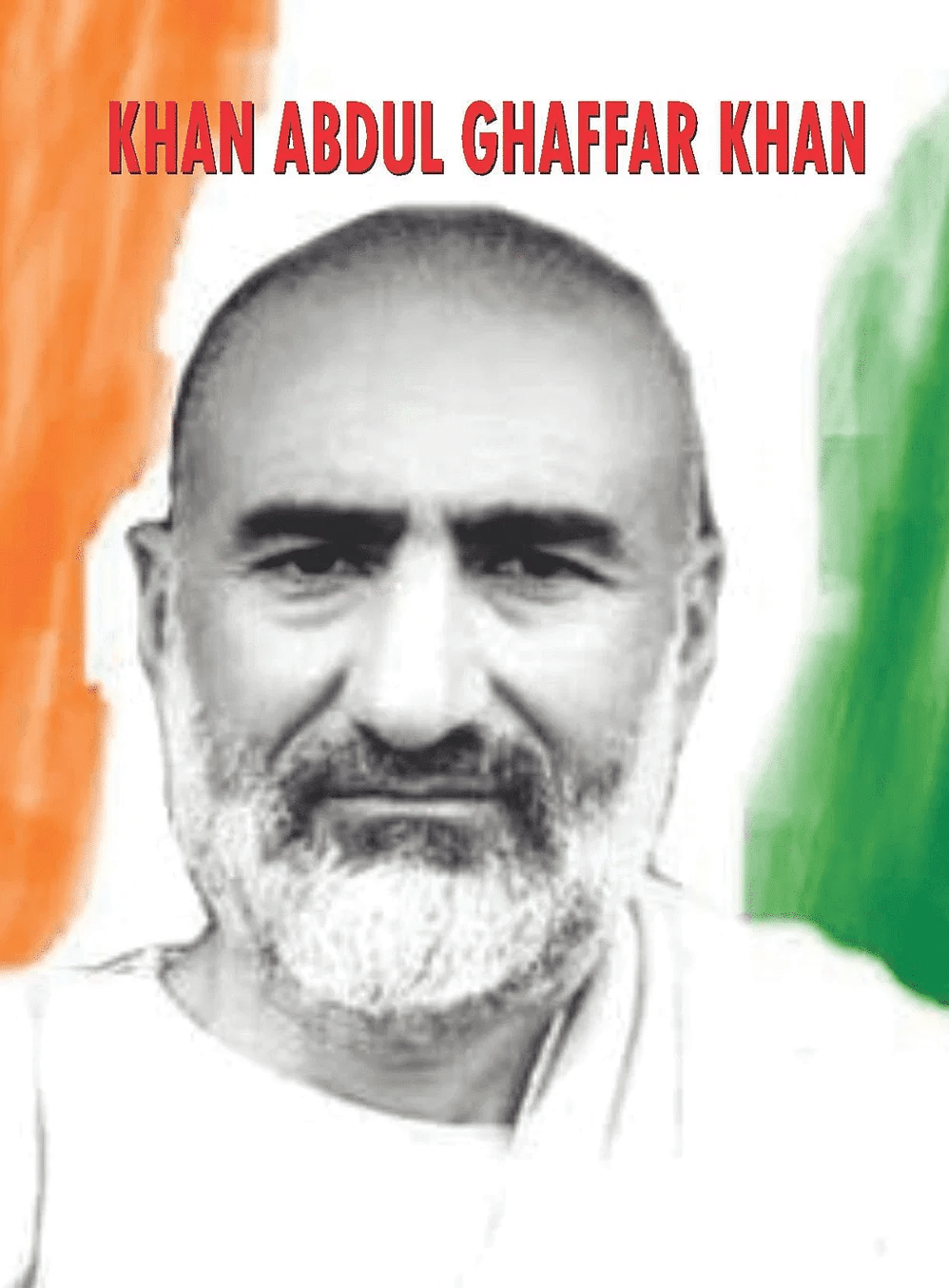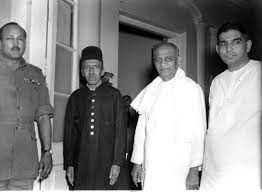Challenges of Nation Building Class 12 Political Science
| Table of contents |

|
| Introduction |

|
| Challenges for the New Nation-State |

|
| Partition: Displacement and Rehabilitation |

|
| Integration of Princely States |

|
| Reorganisation of States |

|
| Conclusion |

|
Introduction
After gaining independence in 1947, India faced a range of challenges in building its nation. Economically, the country struggled with limited resources, a largely agrarian economy, and widespread poverty, which made rapid development difficult. Politically, India grappled with instability stemming from power struggles, the need to establish a functioning democratic system, and instances of corruption.

Challenges for the New Nation-State
- India became independent on the midnight of 14, 15 August 1947.At this time a speech was given by Jawaharlal Nehru which is called Tryst with Destiny.
- After independence India was divided into three parts. Of which the first part was British India, the second part was Pakistan and the third part was the princely states (princely states means the place where the kings used to rule).

Three Challenges
In the immediate wake of India's August 1947 independence, there were three challenges in nation-building.
- Building a united India: India was divided into three different parts. Of which the first part was British India, the second part was Pakistan and the third part was the indigenous princely states. In such a situation, India has to convince those 565 independent princely states to be a part of India, to make a united India and this became a huge became a challenge
- Establish democracy: The Constitution gave everyone basic rights and the right to vote, setting up a parliamentary democracy. While this created a democratic system, the real challenge was making sure democratic practices matched what the Constitution outlined.
- Development: To promote the well-being of all citizens, not just some groups, the Constitution emphasized equality and provided special protection for socially disadvantaged and minority communities. It also outlined welfare goals in the Directive Principles of State Policy. The key challenge was to create effective policies for economic development and poverty reduction.
Partition: Displacement and Rehabilitation
- On August 14-15, 1947, India and Pakistan emerged as two new nations due to the partition of British India.
- The Muslim League's 'two-nation theory' argued that India was made up of two distinct peoples, Hindus and Muslims, and thus demanded a separate Muslim state, Pakistan.
- The Congress opposed this theory and the demand for Pakistan.
- However, political developments in the 1940s, including competition between the Congress and the Muslim League and the British role, led to the creation of Pakistan.
Process of Partition
India and Pakistan became two independent nations on August 14 and 15. Millions of people on both sides suffered communal violence, losing their homes, lives, and property. There were many challenges that the countries faced during the process of partition:
Geographical Challenges: There was no single Muslim-majority region in British India, leading to the creation of Pakistan with two separate areas: West Pakistan and East Pakistan, separated by Indian territory.
Local Opposition: Not all Muslim-majority areas wanted to join Pakistan. Khan Abdul Gaffar Khan of the North-West Frontier Province opposed the partition, but his views were ignored, and the province was included in Pakistan.
Partition of Provinces: Punjab and Bengal, with large non-Muslim populations, were divided based on religious majorities at the district level. This caused confusion and trauma as many people didn’t know if they were in India or Pakistan by August 14-15, 1947.
Minority Issues: Many Hindus and Sikhs in Pakistan and Muslims in India found themselves displaced and unwelcome. The violence that erupted was intense and unforeseen, with no effective plans for managing it, forcing many to leave their homes abruptly.

Consequences of Partition
- One of the greatest, most abrupt, unexpected, and disastrous population transfers in recorded human history occurred in the year 1947. Cities like Lahore, Amritsar, and Kolkata became divided into communal zones, where people avoided areas dominated by other religious communities.
- On both sides of the border, minorities abandoned their homes and found temporary shelter in "refugee camps."
 Refugee Camps during 1947 Partition
Refugee Camps during 1947 Partition
- Women were often abducted, raped, attacked and killed. They were forcefully converted to other religions.
- Political and administrative machinery failed on both sides.
- The partition divided not only communities but also financial assets and government resources. An estimated 8 million people migrated, and between 500,000 to 1 million were killed in the violence.
- Substantial number of property and lives were lost. Communal violence had reached its peak.
Integration of Princely States
British Indian Provinces were directly controlled by the British government. In contrast, the Princely States were ruled by princes who managed their internal affairs but acknowledged British supremacy, known as paramountcy or suzerainty. These Princely States covered one-third of British India's land area, and one-quarter of its population lived under princely rule.
The Problem
- In British India, there were two different sorts of provinces: princely states and British Indian Provinces, which were directly ruled by the British government (governed by Indian princes).
- Immediately after independence there were almost 565 princely states. Many of them joined Indian Union.
- At first, Kashmir, Manipur, Travancore, and Hyderabad all refused joining the Indian Union.
Government’s Approach
- The interim government at the time took decisive action to prevent the possible division of India into small principalities of various sizes.
- The government’s approach was guided by three considerations
1. The people of most of the princely states clearly wanted to become part of the Indian Union.
2. The government was prepared to be flexible in giving autonomy to some regions.
3. Consolidation of the territorial boundaries of the nation had assumed supreme importance.
Instrument of Accession
A Memorandum of Understanding was prepared for the merger of the princely states. This MoU is called Instrument of Accession. Signing this meant that the princely state was ready to join India.
- Most of the princely states agreed to join India, but there were problems in the inclusion of some princely states in India.
- The credit for the inclusion of all the princely states in India goes to Sardar Vallabhbhai Patel.
- Through his understanding and political knowledge, he convinced all the princely states and got them included in India and made an important contribution in making a united India.
Hyderabad
- Hyderabad was one of the largest princely states of India at the time of independence.
- Its ruler was called Nizam.
- The Nizam was one of the richest persons in the world at that time.
- The Nizam wanted Hyderabad to remain separate from India and become an independent state, but the people living in Hyderabad were not happy with his rule.
- Because of which the people of Hyderabad started agitating against the Nizam.
- Seeing all this and to stop this rebellion, the Nizam sent the Razakars.
- The soldiers of Nizam were called Razakars. The Razakars committed robbery, murder and rape.
- In view of this atrocity on the people, in September 1948, the Indian Army attacked Hyderabad so that the general public could be saved from the Razakars.
- This war lasted for a long time and in the end the Nizam had to give up and thus Hyderabad became a part of India.
 Sardar Patel with the Nizam of Hyderabad
Sardar Patel with the Nizam of Hyderabad
Manipur
- Manipur was a princely state located in the east of India.
- The king of this was Bodh Chandra Singh.
- Due to the pressure of the people, the king had to hold elections in June 1948 and in this way the constitutional monarchy was established in Manipur
- There was a lot of difference of opinion in the Legislative Assembly of Manipur on the issue of full accession to India.
- Congress wanted Manipur to join India completely but the rest of the parties did not want it.
- If the resolution to remain separate from India was passed in the assembly, it would have been impossible to include Manipur in India.
- In view of this, the Indian government put pressure on the king of Manipur and got him to sign the complete accession letter, thus Manipur became a part of India.
- The people of Manipur did not like this and the people there were angry with this decision for a long time.

Reorganisation of States
- Indian National Congress acknowledged the need for linguistically-based state reorganisation during the national struggle.
- This plan was put off after Independence because the status of the Princely states was still up in the air and the memory of the division was still vivid.
- Local demands for linguistic states intensified, particularly with the Vishalandhra movement for a separate Andhra state. This forced the central government to act, resulting in the creation of Andhra in December 1952.
- The formation of Andhra spurred demands for states on linguistic lines across the country, leading to the appointment of the States Reorganisation Commission in 1953. The commission's report, accepted by the government, recommended that state boundaries reflect linguistic divisions. The States Reorganisation Act of 1956 created 14 states and 6 union territories.
- The creation of linguistic states, while initially feared to endanger national unity, ultimately strengthened it by addressing regional demands and fostering democratic inclusivity.
- It opened political opportunities beyond the English-speaking elite and underscored India's commitment to diversity and pluralism.
- This approach to state formation affirmed that democracy in India involved recognizing and accommodating differences, thereby enhancing national unity rather than dividing it.
Conclusion
Despite these immense challenges, India managed to unite the princely states, establish a democratic framework, and initiate development, laying the foundation for a diverse and resilient nation.
|
34 videos|308 docs|51 tests
|
FAQs on Challenges of Nation Building Class 12 Political Science
| 1. What were the main challenges faced by the new nation-state after independence? |  |
| 2. How did partition lead to displacement and rehabilitation issues in the new nation? |  |
| 3. What was the process of integrating princely states into the new nation-state? |  |
| 4. What role did the reorganization of states play in nation-building? |  |
| 5. What are the key takeaways regarding the challenges of nation-building in the context of the new nation-state? |  |





















